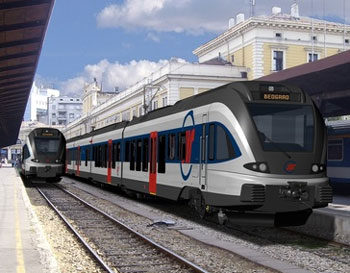Stadler flirting in Serbia
Posted: 4 March 2013 | | No comments yet
Serbian Railways has ordered 21 electric FLIRTs from Stadler Rail for commuter rail services in the Belgrade region…


Serbian Railways (ŽS) has ordered 21 electric FLIRTs (Fast Light Innovative Regional Train) from Stadler Rail for commuter rail services in the Belgrade region. The contract worth around EUR 100 million was signed today in Belgrade. The order is being financed by the European Bank for Reconstruction and Development (EBRD) in London. The vehicles will be delivered in two-week intervals between autumn 2014 and late summer 2015. The trains are very environmentally friendly due to their low energy consumption.


Comfortable and environmentally friendly
The trains have an electric drive for a voltage of 25 kV, 50 Hz. The maximum speed of the modern trains is 160 km/h, and they can be used for three-way traction. The carriage areas can all be accessed without steps and have 234 seats, including 14 tip-up seats and 12 seats in 1st class. The FLIRTs incorporate spacious multifunctional compartments in the entrance area for wheelchairs, prams and bicycles, a wheelchair-accessible toilet and air-conditioning. Emergency intercoms allow passengers to contact the driver.
Join our free webinar: Rail cyber-security in a time of technological and regulatory transformation
Join our expert panel, including speakers from Nokia and Siemens Mobility, to explore the critical convergence of cybersecurity and 5G rail comms.
Date: 3 Dec | Time: 15:00 GMT
Can’t attend live? No worries – register to receive the recording post-event.
The trains will initially have an Indusi train control system, with a subsequent upgrade to the European ETCS 2 standard included at the planning stage. The vehicles are made of lightweight aluminium and are therefore low in weight. This means they can accelerate faster, thus significantly reducing energy consumption and operating costs in comparison to conventional vehicles.
Tailored to customer requirements
Each of the four bodies has one passenger door per side to meet the requirements of Serbian Railways. This highlights one of the real strengths of the FLIRT3 concept: the number of doors and various other features can be adapted variably to meet the customer’s requirements.
The first units will be delivered in autumn 2014. Ten weeks after the delivery of the first vehicle, the remaining 20 trains will be delivered in two-week intervals. Thus, the last vehicle will arrive in late summer 2015.
Stay Connected with Global Railway Review — Subscribe for Free!
Get exclusive access to the latest rail industry insights from Global Railway Review — all tailored to your interests.
✅ Expert-Led Webinars – Gain insights from global industry leaders
✅ Weekly News & Reports – Rail project updates, thought leadership, and exclusive interviews
✅ Partner Innovations – Discover cutting-edge rail technologies
✅ Print/Digital Magazine – Enjoy two in-depth issues per year, packed with expert content
Choose the updates that matter most to you. Sign up now to stay informed, inspired, and connected — all for free!
Thank you for being part of our community. Let’s keep shaping the future of rail together!



